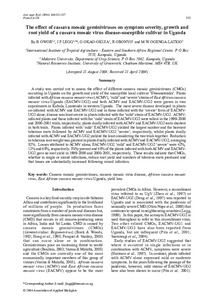| dc.contributor.author | Owor, B. |
| dc.contributor.author | Legg, J.P. |
| dc.contributor.author | Okao‐Okuja, G. |
| dc.contributor.author | Obonyo, R. |
| dc.contributor.author | Ogenga‐Latigo, M.W. |
| dc.date.accessioned | 2019-12-04T11:23:56Z |
| dc.date.available | 2019-12-04T11:23:56Z |
| dc.date.issued | 2004-12 |
| dc.identifier.citation | Owor, B., Legg, J.P., Okao‐Okuja, G., Obonyo, R. & Ogenga‐Latigo, M.W. (2004). The effect of cassava mosaic geminiviruses on symptom severity, growth and root yield of a cassava mosaic virus disease‐susceptible cultivar in Uganda. Annals of Applied Biology, 145(3), 331-337. |
| dc.identifier.issn | 0003-4746 |
| dc.identifier.uri | https://hdl.handle.net/20.500.12478/4219 |
| dc.description.abstract | A study was carried out to assess the effect of different cassava mosaic geminiviruses (CMGs) occurring in Uganda on the growth and yield of the susceptible local cultivar ‘Ebwanateraka’. Plants infected with African cassava mosaic virus (ACMV), ‘mild’ and ‘severe’ strains of East African cassava mosaic virus-Uganda (EACMV-UG2) and both ACMV and EACMV-UG2 were grown in two experiments in Kabula, Lyantonde in western Uganda. The most severe disease developed in plants co-infected with ACMV and EACMV-UG2 and in those infected with the ‘severe’ form of EACMV-UG2 alone; disease was least severe in plants infected with the ‘mild’ strain of EACMV-UG2. ACMV-infected plants and those infected with the ‘mild’ strain of EACMV-UG2 were tallest in the 1999–2000 and 2000–2001 trials, respectively; plants dually infected with ACMV and EACMV-UG2 were shortest in both trials. Plants infected with ‘mild’ EACMV-UG2 yielded the largest number and the heaviest tuberous roots followed by ACMV and EACMV-UG2 ‘severe’, respectively, whilst plants dually infected with ACMV and EACMV-UG2 yielded the least considering the two trials together. Reduction in tuberous root weight was greatest in plants dually infected with ACMV and EACMV-UG2, averaging 82%. Losses attributed to ACMV alone, EACMV-UG2 ‘mild’ and EACMV-UG2 ‘severe’ were 42%, 12% and 68%, respectively. Fifty percent and 48% of the plants infected with both ACMV and EACMV-UG2 gave no root yield in 1999–2000 and 2000–2001, respectively. These results indicate that CMGs, whether in single or mixed infections, reduce root yield and numbers of tuberous roots produced and that losses are substantially increased following mixed infection. |
| dc.description.sponsorship | Rockefeller Foundation |
| dc.language.iso | en |
| dc.subject | Cassava |
| dc.subject | Geminiviruses |
| dc.subject | Cassava Mosaic Viruses |
| dc.subject | Yield Loss |
| dc.title | The effect of cassava mosaic geminiviruses on symptom severity, growth and root yield of a cassava mosaic virus diseasesusceptible cultivar in Uganda |
| dc.type | Journal Article |
| dc.description.version | Peer Review |
| cg.contributor.crp | Roots, Tubers and Bananas |
| cg.contributor.affiliation | International Institute of Tropical Agriculture |
| cg.contributor.affiliation | Makerere University |
| cg.coverage.region | Africa |
| cg.coverage.region | East Africa |
| cg.coverage.country | Uganda |
| cg.isijournal | ISI Journal |
| cg.authorship.types | CGIAR and developing country institute |
| cg.iitasubject | Cassava |
| cg.iitasubject | Plant Diseases |
| cg.accessibilitystatus | Limited Access |
| local.dspaceid | 99785 |
| cg.identifier.doi | https://doi.org/10.1111/j.1744-7348.2004.tb00390.x |

